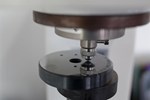
Published:
03/24
When selecting the right material for your CNC machined part, hardness is often one of the key considerations. Harder materials resist deformation and scratches, making them longer-lasting and easier to clean and maintain. However, you will often sacrifice toughness if you require a hard material. It may sound contradictory, but if you take glass as an example, it is hard, but its toughness is extremely weak, making it very fragile. On the other side of the scale, plastics are often tough but less resistant to surface and impact damage than metals.